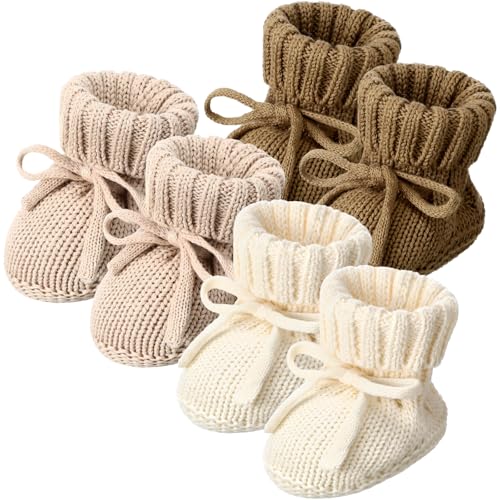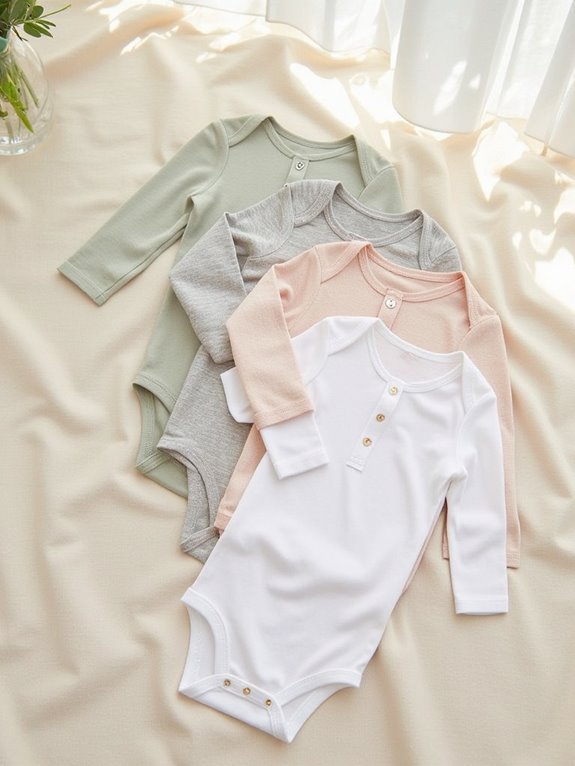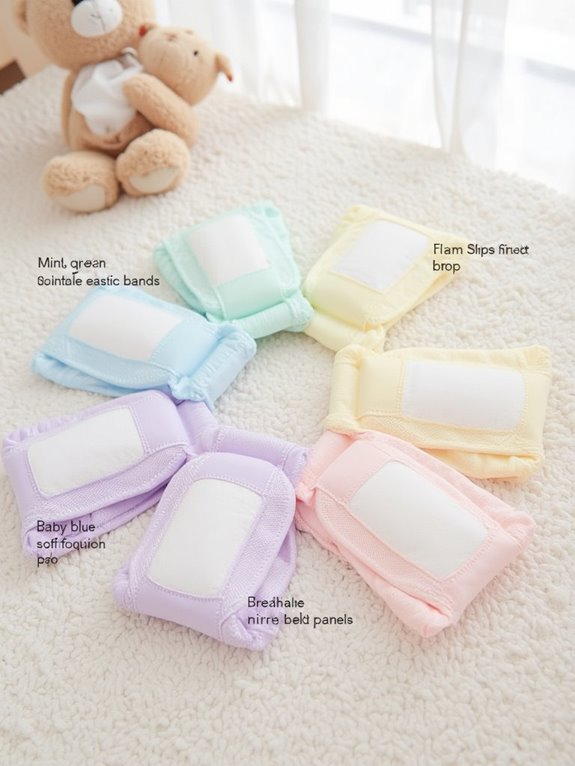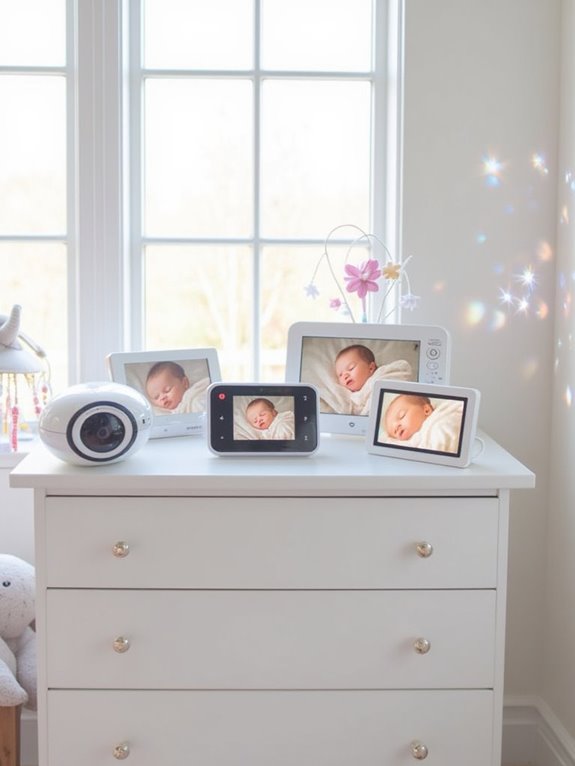Links below are affiliate links. We earn a commission on purchases at no extra cost to you. Although our opinions are based on curated research, we haven't used these products. Articles generated with AI.
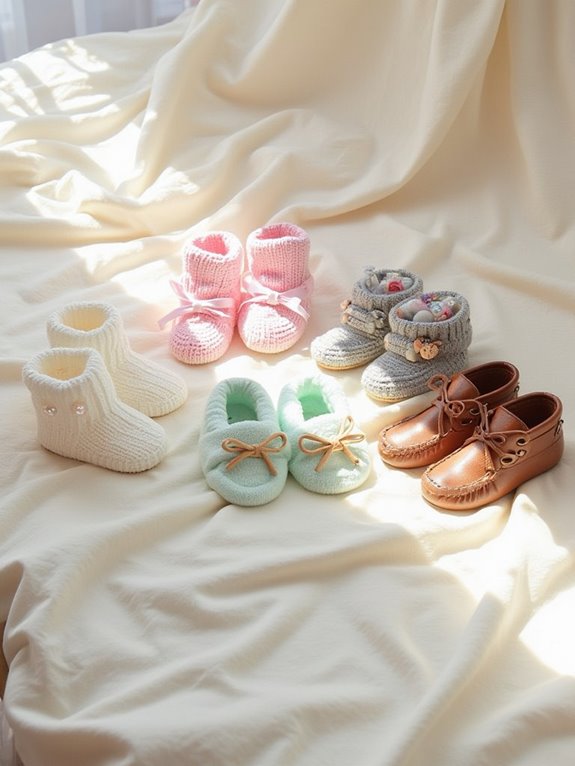
5 Best Baby Booties
The top-rated baby booties combine comfort, safety, and reliable fit features. Gerber’s Fleece-Lined Non-Skid Booties offer certified safety and warmth, while DovFanny’s knit booties provide gender-neutral style. For early walkers, consider Baby Booties Newborn Slippers with Velcro straps and grip soles. Hadetoto’s adjustable designs ensure a secure fit, and the 3 Pairs Knitted set works well for special occasions. Each option brings unique benefits worth exploring for your baby’s specific needs.
Key Takeaways
- DovFanny Baby Booties offer cozy knit material suitable for both genders, making them comfortable and versatile for everyday wear.
- Gerber Unisex-Baby Booties feature plush fleece lining and non-slip soles, ideal for early walking stages and indoor use.
- Baby Booties Newborn Slippers include adjustable Velcro straps for secure fit and gentle cushioning for walking practice.
- Choose booties with elastic ankles, adjustable straps, or drawstrings to prevent slip-offs during active movement.
- Natural fibers like cotton and wool provide optimal temperature regulation and breathability while preventing skin irritation.
3 Pairs Knitted Baby Booties for Newborns (0-6 Months)
Evervibe 3 Pairs Knitted Baby Booties 0-6 Months Newborn Baby Shoes First Walkers Cozy Shoes for...
- 100% Cotton Comfort: our walkers socks shoes are made from cotton, ensuring a soft and breathable experience for your little one; The gentle fabric is safe for baby's...
- Two-in-one Crochet Shoes: these baby booties serve as both socks and shoes, making them ideal for newborns; They provide protection from the cold wind during winter...
- Easy on and off: putting on and taking off these shoes is a breeze; Simply slide your baby's feet in like a pair of loafers, and the lace outside will securely fasten,...
While these knitted baby booties come in a set of three pairs designed for newborns aged 0-6 months, they’re best suited for decorative purposes rather than everyday wear. Customer feedback reveals inconsistent quality across the pairs, with fit issues that make them impractical for infant use.
Key considerations:
- Sizing runs wide but short, causing difficulty staying on feet
- One pair typically meets quality standards while two may have defects
- Tan booties lack proper foot shaping
- Bottom stitching creates unusable design
These booties excel as baby shower decorations when filled with rice or floral foam. While visually appealing for events, they don’t provide reliable daily footwear for infants.
Best For: Party planners and event organizers seeking decorative elements for baby showers and infant-themed celebrations who prioritize aesthetic appeal over functional baby wear.
Pros:
- Excellent decorative pieces when used as centerpieces or filled with materials for displays
- Visually appealing and receives positive feedback at events
- Versatile for creative DIY projects and party decorations
Cons:
- Inconsistent quality with two out of three pairs often showing defects
- Poor fit for actual infant use with width and length proportion issues
- Some pairs lack proper foot shaping and have unusable design features
DovFanny Baby Booties for Newborn Boys & Girls
DovFanny Baby Booties Newborn Baby First Shoes Cozy Warm Knit Soft Booties for Toddler Infant Boy...
- 100% handmade crochet baby shoes, made by good quality core -spun yarn ,very soft and warm , safe to baby's skin and give babies comfy feelings.
- Easy On and Off- These baby booties shoes is Easy to put On and Off, and they will stay on your baby's feet.
- The newborn baby booties are also stylish, and would make a great addition to any baby closet.
Parents seeking adorable yet functional footwear for their newborns will appreciate DovFanny Baby Booties’ cozy knit design. These well-crafted booties offer comfort for extended wear and feature high-quality workmanship with no visible flaws.
While the booties photograph beautifully and make excellent gifts, there’s a practical limitation to contemplate: they can slip off easily when babies kick actively. Some customers have reported receiving mismatched pairs or single shoes, suggesting potential quality control issues.
Key Features:
- Suitable for both boys and girls
- Easy to put on
- Comfortable for long-term wear
- Machine or hand-knitted construction
- Available for newborns through toddler ages
Best For: Parents and gift-givers looking for cute, photography-friendly baby footwear for newborns and toddlers who aren’t yet highly active.
Pros:
- Beautiful craftsmanship with high-quality knit construction
- Easy to put on and comfortable for extended wear
- Versatile design suitable for both boys and girls
Cons:
- Tendency to slip off with active kicking
- Some quality control issues with mismatched or missing shoes
- Limited practical functionality beyond aesthetic purposes
Baby Booties Newborn Slippers and Crib Shoes
QWZban Baby Booties Infant Newborn Boys Girls Slippers Warm Crib Sock Shoes Indoor First Walker...
- 【 LMPORTED SAFETY MATERIAL】-100% Polyester fleece Lining;Supper cozy fleece booties, breathable, elastic ankle support and non-skid sole. No any stimulation to the...
- 【DESIGNED FOR YOUR BABY】-EASY ON AND OFF, the faux suede leather sole gives these a strong grip that guards against trips or falls. Optimal for everyday use, ideal...
- 【DURABLE & STYLISH】-Once you have a baby crawling around the house, you know how important durability in your baby's clothing and accessories becomes. Our cozy baby...
These versatile newborn slippers and crib shoes offer essential protection for babies aged 8-14 months who haven’t started walking outdoors yet. The adjustable Velcro strap ensures a secure fit, preventing the booties from slipping off active infants.
You’ll find these slippers particularly useful for:
- Indoor walking practice
- Daycare environments
- Stroller rides in cool weather
- Keeping feet warm when socks are kicked off
The design accommodates different foot widths, including chubby feet, while providing gentle cushioning and bottom grip for stability. Though sizes may run slightly large, the adjustable strap compensates for fit variations. The durable materials are easy to clean and maintain, making these a practical choice for daily indoor use.
Best For: Parents seeking warm, secure indoor footwear for babies aged 8-14 months who are learning to walk or need protection during indoor activities and cool weather.
Pros:
- Adjustable Velcro strap ensures booties stay on even with active movement
- Soft, comfortable materials with grip bottom for safety during early walking
- Easy to clean and maintain, making them practical for daily use
Cons:
- Sizes tend to run large, which might require sizing down
- Limited to indoor use only, not suitable for outdoor walking
- May be too warm for use during hot weather or in heated environments
Hadetoto Baby Booties for Newborn & Toddler
Sale
Hadetoto Baby Booties Newborn First Walkers Cozy Shoes Warm Knit Soft Booties for Toddler Infant Boy...
- 100% Cotton: this baby first outing socks shoes is made of premium cotton, very soft and breathable, safe to baby's skin and give babies comfy feelings.
- Easy On and Off- These baby booties shoes is Easy to put On and Off, and they will stay on your baby's feet.
- Best gift- Stylish Adorable Cozy baby shoes is Best Shower Gift for Newborn. Great for daily use and make a perfect Baby Shower, Birthday Present.
Knit booties with adjustable strings make Hadetoto’s design ideal for parents who want footwear that’ll stay securely on their little one’s feet. These well-constructed shoes fit babies 0-6 months, though some find the 6-9 month size runs small.
The high-quality soft knit material offers both durability and comfort. You’ll find these white booties versatile enough for daily wear, special occasions, or photo sessions. They’re particularly useful for:
- Everyday protection
- Photography props
- Baby shower gifts
- Diaper cake decorations
- Matching accessory sets
While machine wash capabilities aren’t confirmed, the booties maintain their shape with gentle cleaning. The secure fit comes from proper string adjustment, preventing slipping during use.
Best For: Parents seeking soft, adjustable baby booties that work well for both everyday wear and special occasions like photo sessions or baby showers.
Pros:
- Adjustable strings ensure a secure fit and prevent slipping off
- High-quality soft knit material provides both comfort and durability
- Versatile design works for multiple purposes from daily wear to photography props
Cons:
- Size inconsistency issues, particularly with 6-9 month sizing running small
- Machine wash durability not confirmed
- Limited color options (only available in white)
Gerber Unisex-Baby Fleece Lined Non Skid Soft Slipper Booties with Ears
Sale
Gerber Baby Fleece Lined Non Skid Soft Slipper Booties, Grey Ears, 6 9 Months Unisex Infant
- Includes one pair of grey, plush booties with adorable fuzzy ear detail
- Non-skid cotton canvas sole
- Soft poly fleece interior lining
Designed for both indoor comfort and early walking stages, the Gerber Unisex-Baby Fleece Lined Non Skid Soft Slipper Booties with Ears stand out as an ideal choice for parents seeking a balance between warmth and safety.
These OEKO-TEX® certified booties feature a plush poly-fleece lining and non-skid cotton canvas soles that support balance development. You’ll find them easy to put on thanks to the heel loop design, and they’ll stay securely on your baby’s feet. While they run slightly large to accommodate growth, sizes range from 3-6 months to 6-9 months. The washable design maintains its softness through multiple cleaning cycles.
Best For: Parents seeking comfortable, safe indoor footwear for babies who are learning to walk or need warm slippers during colder months.
Pros:
- Non-skid cotton canvas soles provide excellent grip and support for early walking stages
- Plush poly-fleece lining ensures warmth and comfort while being independently certified safe
- Easy to put on and take off with convenient heel loop design
Cons:
- Size range is limited, with no options available for babies 9-12 months
- Runs slightly large, which might be challenging for smaller babies
- Some color options (particularly brown) appear darker than shown in product images
Factors to Consider When Choosing Baby Booties
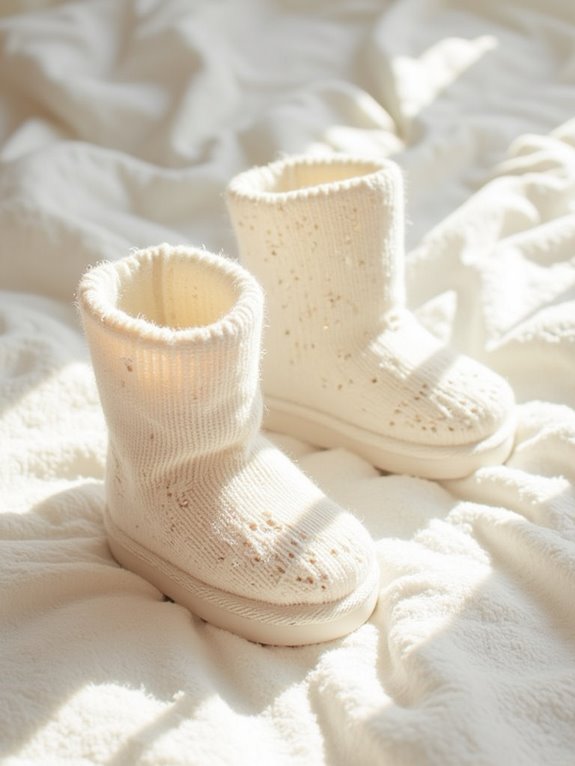
When shopping for baby booties, you’ll need to evaluate several critical factors to guarantee your baby’s comfort and safety. Consider the size with room for growth, material quality for breathability, and secure design features that prevent the bootie from slipping off during movement. You’ll also want to decide between indoor-only soft soles versus outdoor-ready hard soles, making sure any option includes non-slip grips to prevent falls as your baby begins to cruise and walk.
Size and Growth Allowance
Selecting the right size for baby booties stands as a crucial factor in ensuring your little one’s comfort and proper foot development. You’ll want to focus on allowing enough space for growth, typically adding 1/4 to 1/2 inch beyond your baby’s current foot measurements.
Key Sizing Guidelines:
- Measure your baby’s feet directly instead of relying solely on age-based sizing
- Choose booties with adjustable features like straps or ties
- Ensure there’s room for natural foot movement and growth
- Avoid restrictive fits that could impair circulation
While many manufacturers label sizes by months, these serve only as general guidelines. You’ll need to check the specific size chart for each brand and compare it to your baby’s actual measurements. Remember that a proper fit shouldn’t be too loose (risking slip-offs) or too tight (restricting movement).
Material Quality and Comfort
Material quality serves as the foundation for comfortable and safe baby booties, with specific fabrics playing a vital role in your little one’s foot health. When selecting booties, you’ll want to focus on soft, breathable materials that prevent skin irritation.
Key material considerations:
- Natural fibers like cotton and wool provide optimal temperature regulation
- Stretchy, elasticized openings ensure easy on-off wear
- Durable fabrics maintain shape through multiple wash cycles
- OEKO-TEX® certified materials guarantee safety from harmful chemicals
Look for booties made with knit fabrics that offer proper insulation without causing overheating. The material should feel soft against your baby’s skin while providing enough flexibility for natural foot movement. Quality materials will retain their properties even after repeated washing, making them a practical long-term choice for your baby’s comfort.
Stay-On Design Features
The most essential aspect of baby bootie design centers on features that keep them securely in place during movement. You’ll want to look for specific elements that prevent booties from slipping off during your baby’s active moments.
Key stay-on features to consider:
- Elastic ankles that create a gentle, secure fit
- Adjustable straps or drawstrings for customizable security
- Heel tabs that make putting booties on and taking them off easier
- Non-slip soles with textured or rubber surfaces for grip
- Velcro or snap closures for precise fit adjustment
When evaluating fit, ensure the booties aren’t too loose or tight. A proper fit is crucial – loose booties will slip off during kicks and crawls, while overly tight ones can cause discomfort and actually increase the likelihood of them coming off.
Indoor Versus Outdoor Use
When choosing baby booties, you’ll need to carefully consider whether they’ll be worn primarily indoors or outdoors, as each environment demands distinct features for ideal safety and comfort.
Indoor Booties:
- Soft, breathable materials that allow natural foot movement
- Lightweight construction for unrestricted crawling and walking
- Flexible soles that support foot development
- Snug fit to maintain warmth without constriction
Outdoor Booties:
- Durable, water-resistant materials for protection
- Reinforced heels and soles for rough surfaces
- Anti-slip grips to prevent falls
- Additional support for outdoor activities
You’ll want to select booties that match your baby’s primary environment. Using indoor booties outside can lead to premature wear and insufficient protection, while outdoor styles might be too restrictive for indoor play and development.
Safety and Non-Slip Soles
Safety considerations for baby booties must prioritize non-slip soles, since secure footing directly impacts your little one’s stability and confidence while learning to walk. You’ll want to select booties with textured or rubberized soles specifically engineered for maximum grip on indoor surfaces.
Key features to examine:
- Sole material: Look for rubber or specialized non-skid fabrics
- Traction pattern: Check for adequate texture designed for grip
- Surface compatibility: Ensure effectiveness on hardwood and tile floors
Maintenance Requirements:
- Inspect soles regularly for signs of wear
- Replace booties when grip surfaces show deterioration
- Test traction periodically on different floor types
When your baby shifts from crawling to walking, proper non-slip soles become essential for preventing accidents and supporting natural development of walking skills.
Ease of Cleaning
Maintaining clean baby booties becomes considerably easier when you select models with machine-washable materials and simple designs. You’ll want to look for options made from soft cotton or knit fabrics that won’t lose their shape in the wash.
When evaluating bootie designs, choose styles with:
- Minimal seams to prevent dirt buildup
- Limited decorative elements that could complicate cleaning
- Machine-washable construction
- Clear care instructions for washing and drying
- Removable insoles for thorough cleaning
Before purchasing, check the manufacturer’s care label to confirm if the booties can go in your dryer or require air drying. This information helps you sustain the booties’ quality through multiple wash cycles. Proper cleaning not only extends the life of the booties but also ensures suitable foot hygiene for your baby.
Frequently Asked Questions
How Do I Measure My Baby’s Feet Correctly for Booties?
To measure your baby’s feet accurately for proper sizing:
- Have your baby stand/place feet flat on paper (if able to stand)
- Trace around each foot with a pencil held vertically
- Measure length from heel to longest toe
- Measure width at widest part
- Add 1/2 inch for growth room
For non-walking babies, gently press feet flat while seated. Take measurements in the afternoon when feet are naturally more swollen.
Can Babies Wear Booties While Learning to Walk?
Yes, babies can wear booties while learning to walk, but you’ll need to choose the right type. For indoor walking, select booties with non-slip soles and flexible materials that allow natural foot movement. For outdoor walking, opt for more structured booties with:
- Ankle support
- Breathable materials
- Properly fitted size
- Rubber or soft leather soles
Remove booties during designated barefoot practice time to help develop balance and coordination.
How Often Should Baby Booties Be Washed?
Just as a fresh morning dew refreshes nature, clean booties protect your baby’s delicate feet. You’ll want to wash your baby’s booties every 2-3 days with regular wear, or immediately if they become visibly soiled or wet. For hygiene and safety:
- Machine wash in warm water (30°C/86°F)
- Use mild, baby-safe detergent
- Air dry completely before next use
- Wash more frequently if your baby sweats heavily
- Always check care labels for specific instructions
What’s the Best Way to Prevent Babies From Kicking off Booties?
To keep booties securely on your baby’s feet, you’ll want to try these proven methods:
- Choose booties with elastic or adjustable ankle straps
- Use booties with snap or velcro closures
- Select styles with ribbed cuffs that extend past the ankle
- Layer thin socks underneath for extra grip
- Opt for booties in the correct size – too large will slip off easily
For active babies, ankle-high styles with double-closure systems work best.
Are Baby Booties Necessary for Newborns Who Don’t Move Much?
While newborns don’t move much, baby booties serve important purposes beyond movement control. They help regulate your baby’s body temperature since infants can’t efficiently maintain their own warmth. You’ll want to use booties when:
- Room temperature falls below 70°F
- During outdoor trips
- For nighttime sleep
- In air-conditioned spaces
However, when indoors at comfortable temperatures (72-75°F), regular socks or bare feet are fine for stationary newborns.

